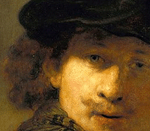
"Pharisee and the Publican"
Although religious conversion always bears fruit in a person’s life, that fruit is sometimes not visible to the casual observer. In the case of the French artist James Tissot (1836-1902), however, the evidence of his conversion 125 years ago is still plain for all to see.
According to his own account, Tissot, at around age 48, saw a vision during Mass in the Church of St. Sulpice in Paris. Until that time his paintings had focused primarily on high-society life in Paris and London. After his mystical experience, Tissot’s work changed markedly. His next painting, “Inward Voices,” depicts his vision: an impoverished couple sit on the rubble of a building in ruins; beside them sits Jesus—scourged, bleeding and wearing a crown of thorns, yet present to comfort them. Tissot’s religious experience at St. Sulpice resulted in a lifelong directional shift in his artistic work.
Four years later, after his vision, Tissot undertook an artistic project that led him to study archeology and the Bible, and he traveled three times to the Middle East, where he filled sketchbooks with images of the people and places he observed. Drawing upon his photos, sketches and nearly 100 finished drawings, Tissot created a suite of 350 watercolors, entitled “The Life of Our Lord Jesus Christ,” commonly known as “The Life of Christ,” a chronology from Jesus’ birth to the Ascension. It took the artist 10 years to make these vivid, detailed and emotive images. Some are miniature masterpieces; only the major episodes in Jesus’ life are larger in size than a standard sheet of paper. The narrative work includes portraits and landscapes, aerial views and close-ups, intimate moments and vast crowd scenes.
Tissot thought the culture of the Middle East had not changed much since the time of Jesus and so worked diligently to capture the similarity on paper before modernity could erase it. But this “mistake” accounts for some of the admirable documentary detail of his work: the patterns of rugs, tiles, lattices, textiles, capitals and costumes; and the precise rituals and pageantry, including the segregated society of men and women. Jesus walks through narrow passageways; sits in dark, moonlit rooms; strides down stone streets; and when not on the sea, traverses a pink, gold or blue landscape with oases of palms and olive trees that is starkly beautiful—its rock piles casting gray and mauve shadows. At times one also sees the Jerusalem of Tissot’s day—its red-and-white striped buildings bleached white in the gleaming sun.
Tissot’s people are dynamic and lifelike. Tissot’s cast of characters extends beyond the leading roles to include townspeople whom viewers can recognize throughout the series.
To believers, Tissot’s images reveal something more: signs of a vibrant Christian imagination. He did more than represent the land where Jesus walked. Tissot saw himself as a spiritual pilgrim. He reflected on each image and seems to have placed himself in the scenes as the various characters, much as St. Ignatius Loyola recommends in the Spiritual Exercises: as a prodigal son, a child of Jerusalem, a Roman soldier, a mother with a sick child, a condemned thief, a woman at the empty tomb and a convinced follower. Tissot’s visionary images can also help viewers to do the same.